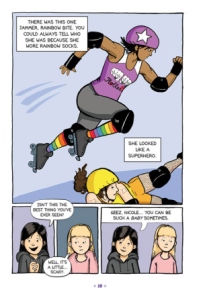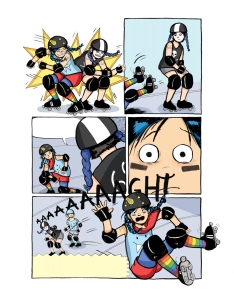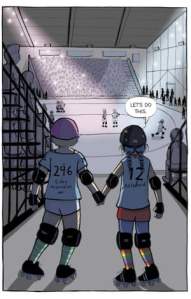 Transitions. Whether it is tweens careening towards adolescence or winter blossoming into spring, the change is predictable–even if the pace is not! This is why fickle March seems an apt moment to catch up with two award-winning graphic novels about tweens. I read these engaging books by author/illustrator Victoria Jamieson when they first appeared but only today found the “right ” time and place to discuss them.
Transitions. Whether it is tweens careening towards adolescence or winter blossoming into spring, the change is predictable–even if the pace is not! This is why fickle March seems an apt moment to catch up with two award-winning graphic novels about tweens. I read these engaging books by author/illustrator Victoria Jamieson when they first appeared but only today found the “right ” time and place to discuss them.
 Just as this review is somewhat late, twelve-year old Astrid Vasquez, the central character in Roller Girl (2015), finds herself out of step with her childhood best friend Nicole. The double spread prologue of this Newberry Honor winner sets up its narrator’s problem: Astrid wordlessly grimaces as she overhears herself being called a baby for roller skating in a park rather than shopping at a mall. Nicole and her new, jeering 6th grade pals, unlike Astrid, are into fashion and crushes, but—even more fundamentally—ballet-loving Nicole is horrified by rough-and-tumble events.
Just as this review is somewhat late, twelve-year old Astrid Vasquez, the central character in Roller Girl (2015), finds herself out of step with her childhood best friend Nicole. The double spread prologue of this Newberry Honor winner sets up its narrator’s problem: Astrid wordlessly grimaces as she overhears herself being called a baby for roller skating in a park rather than shopping at a mall. Nicole and her new, jeering 6th grade pals, unlike Astrid, are into fashion and crushes, but—even more fundamentally—ballet-loving Nicole is horrified by rough-and-tumble events.
This difference is highlighted humorously when Mrs.  Vasquez’ latest surprise “evening cultural event” for the two girls is a women’s roller derby contest! Nicole is dismayed, attempting to shield her eyes with her hands, but Astrid is thrilled, even convincing her mom to sign her up for junior roller derby summer camp. To that end, Astrid lets her mother mistakenly believe that Nicole will also be attending that camp, and that Nicole’s mother will drive both girls back home from camp each day.
Vasquez’ latest surprise “evening cultural event” for the two girls is a women’s roller derby contest! Nicole is dismayed, attempting to shield her eyes with her hands, but Astrid is thrilled, even convincing her mom to sign her up for junior roller derby summer camp. To that end, Astrid lets her mother mistakenly believe that Nicole will also be attending that camp, and that Nicole’s mother will drive both girls back home from camp each day.
Roller Girl is an insightful, frequently humorous look at the psychological and social challenges tweens face. Besides vividly conveying the thrills and spills of roller derby as a team-building sport, Jamieson focuses on what Astrid learns about herself. Lying to her mother is as uncomfortable as any of the falls Astrid takes, and she has a hard time figuring out how to relate to Nicole as well as her new team friend Zoey. Confronted by her disappointed mother about her lies, Astrid blurts out, “Maybe I don’t know who I am either.” Yet in the remaining 4 chapters of this 16 chapter book, Jamieson does a great job showing Astrid puzzling out some answers to that mystery. This Latinx character gains confidence as she works hard to expand her physical and mental limits.
 Vivid colors, close- ups varying with mid and long distance views, different panel sizes and shapes, and expressive body language and facial features drawn with bold, minimal strokes—all combine to make Roller Girl an entertaining work that, in Jamieson’s own words, is about “fun, family, and character.” That insight, along with others about how she created this graphic novel, is available in a downloadable e-book at Jamieson’s website. There we also learn how the graphic novel relates to the author/illustrator’s own life and how the punning, mock-aggressive derby names of Roller Girl’s characters are based on real-life team players.
Vivid colors, close- ups varying with mid and long distance views, different panel sizes and shapes, and expressive body language and facial features drawn with bold, minimal strokes—all combine to make Roller Girl an entertaining work that, in Jamieson’s own words, is about “fun, family, and character.” That insight, along with others about how she created this graphic novel, is available in a downloadable e-book at Jamieson’s website. There we also learn how the graphic novel relates to the author/illustrator’s own life and how the punning, mock-aggressive derby names of Roller Girl’s characters are based on real-life team players.
For instance, “Panda-monium” and “ThrillaGodzilla” are teammates who accompany Astrid as she soars towards adulthood as roller derby’s “Asteroid.”  Derby names provide sly fun here, alongside some images that are visual jokes about narrator Astrid’s thoughts and words. For instance, when she thinks about an old-fashioned, strict teacher, Jamieson depicts a fierce dinosaur and prehistoric fauna. When Astrid is most despairing, readers see a large reddish image of what she childishly imagines as hell. Yet as the more self-aware “Asteroid,” this character does resume a limited friendship with Nicole. Astrid’s adolescence may not keep pace with Nicole’s—and Astrid’s teen years and adulthood may not resemble Nicole’s apparently conventional path—but Jamieson’s heroine matures and is happy as the novel concludes.
Derby names provide sly fun here, alongside some images that are visual jokes about narrator Astrid’s thoughts and words. For instance, when she thinks about an old-fashioned, strict teacher, Jamieson depicts a fierce dinosaur and prehistoric fauna. When Astrid is most despairing, readers see a large reddish image of what she childishly imagines as hell. Yet as the more self-aware “Asteroid,” this character does resume a limited friendship with Nicole. Astrid’s adolescence may not keep pace with Nicole’s—and Astrid’s teen years and adulthood may not resemble Nicole’s apparently conventional path—but Jamieson’s heroine matures and is happy as the novel concludes.
 In All’s Faire in Middle School (2017), Jamieson again uses an unusual pastime to highlight the trials kids typically may undergo in middle school. Eleven-year old Imogene Vega, whose Florida family are Renaissance Fair enactors, has been homeschooled but is now enrolled in public middle school. She nervously waits to see how her beloved festival’s recreated royal court traditions of “Honesty, Chivalry, and Bravery” will play out in school classrooms, hallways, and—in the social setting Imogene fears most–“Lunch.” A full page image of the lunchroom looming ahead of Imogene, summed up by that one word, depicts just how overwhelmed she feels. In other scenes, Imogene’s feeling like a “ghost” in the crowds of kids is reinforced by pastel colors in panels replacing the novel’s otherwise vivid hues. Unlike Roller Girl, Jamieson shows her Latinx main character encountering discrimination. Imogene sees how in her father’s “day job” as a store manager, Mr. Vega faces a dissatisfied customer who sarcastically calls him “Amigo” while negatively referring to Mr. Vega’s dark skin and features.
In All’s Faire in Middle School (2017), Jamieson again uses an unusual pastime to highlight the trials kids typically may undergo in middle school. Eleven-year old Imogene Vega, whose Florida family are Renaissance Fair enactors, has been homeschooled but is now enrolled in public middle school. She nervously waits to see how her beloved festival’s recreated royal court traditions of “Honesty, Chivalry, and Bravery” will play out in school classrooms, hallways, and—in the social setting Imogene fears most–“Lunch.” A full page image of the lunchroom looming ahead of Imogene, summed up by that one word, depicts just how overwhelmed she feels. In other scenes, Imogene’s feeling like a “ghost” in the crowds of kids is reinforced by pastel colors in panels replacing the novel’s otherwise vivid hues. Unlike Roller Girl, Jamieson shows her Latinx main character encountering discrimination. Imogene sees how in her father’s “day job” as a store manager, Mr. Vega faces a dissatisfied customer who sarcastically calls him “Amigo” while negatively referring to Mr. Vega’s dark skin and features.
 Imogene ultimately learns that it is better to stand up for her values than try to fit into cliques that jeer at poor or awkward tweens. She shows herself to be a valiant “squire” outside of weekend Faire days, standing up to several kinds of bullies. Along the way, Imogene gains some new school friends, discovers that one critical teacher is not an enemy “dragon,” and regains the trust of younger brother Felix and her extended, supportive Renaissance Faire “family.” Readers will enjoy the way Jamieson weaves these characters’ use of “colorful Elizabethan language” into this widely-praised novel. For example, blunt-talking Gussie helps Imogene practice her squire’s spiel by jokingly saying, “Thou spongy ill-nurtured strumpet! Thy breath stinks with eating toasted cheese.”
Imogene ultimately learns that it is better to stand up for her values than try to fit into cliques that jeer at poor or awkward tweens. She shows herself to be a valiant “squire” outside of weekend Faire days, standing up to several kinds of bullies. Along the way, Imogene gains some new school friends, discovers that one critical teacher is not an enemy “dragon,” and regains the trust of younger brother Felix and her extended, supportive Renaissance Faire “family.” Readers will enjoy the way Jamieson weaves these characters’ use of “colorful Elizabethan language” into this widely-praised novel. For example, blunt-talking Gussie helps Imogene practice her squire’s spiel by jokingly saying, “Thou spongy ill-nurtured strumpet! Thy breath stinks with eating toasted cheese.”
 Humorous moments such as that occur throughout the novel. Readers unfamiliar with re-enactments will find the 13 full-page chapter introductions here useful as well as charming. Each is drawn like a medieval or Renaissance manuscript page, with a swirling, intricate border surrounding an apt image and information. An online book trailer, giving this work’s flavor, is also a fine introduction to faires. Despite the travails Imogene experiences, the book ends on a warm and upbeat note, with a final full-page image of Imogene and Felix enjoying their view of the stars.
Humorous moments such as that occur throughout the novel. Readers unfamiliar with re-enactments will find the 13 full-page chapter introductions here useful as well as charming. Each is drawn like a medieval or Renaissance manuscript page, with a swirling, intricate border surrounding an apt image and information. An online book trailer, giving this work’s flavor, is also a fine introduction to faires. Despite the travails Imogene experiences, the book ends on a warm and upbeat note, with a final full-page image of Imogene and Felix enjoying their view of the stars.
 Rereading these graphic works, I was happy to discover that Victoria Jamieson has also written two graphic novels for younger readers: The Great Pet Escape (2016) and its sequel, The Great Art Caper (2017). I look forward to seeing what fantasy adventures Jamieson has crafted for the classroom pets of Daisy P. Flugelhorn Elementary School! I wonder how this talented author/illustrator has tied these central characters into the daily lives of elementary school kids.
Rereading these graphic works, I was happy to discover that Victoria Jamieson has also written two graphic novels for younger readers: The Great Pet Escape (2016) and its sequel, The Great Art Caper (2017). I look forward to seeing what fantasy adventures Jamieson has crafted for the classroom pets of Daisy P. Flugelhorn Elementary School! I wonder how this talented author/illustrator has tied these central characters into the daily lives of elementary school kids.
